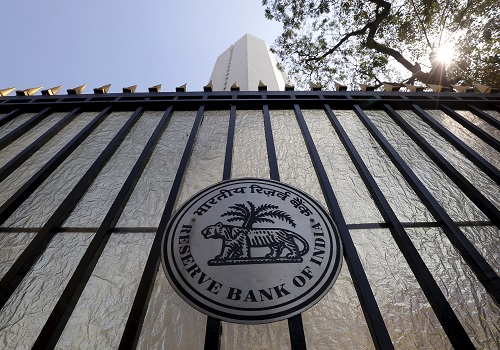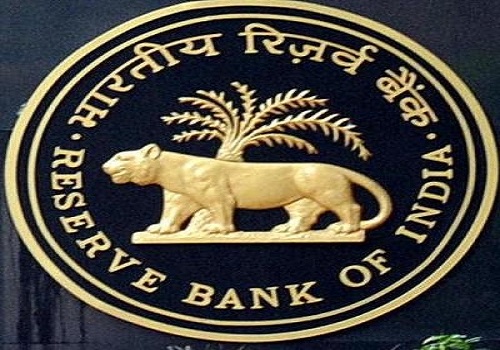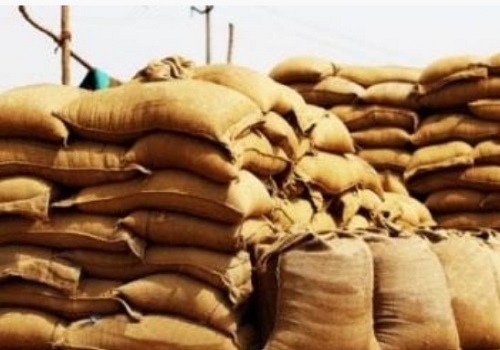Gold trading range for the day is 65760-66320 -Kedia Advisory

Follow us Now on Telegram ! Get daily 10 - 12 important updates on Business, Finance and Investment. Join our Telegram Channel
Gold
Gold prices inched up by 0.02%, settling at 66035, as the U.S. labor market showed signs of slowing down, prompting investors to eagerly await U.S. inflation data for insights into the potential timeline for rate cuts. Despite February's payrolls figure surpassing forecasts, revisions to job gains in January and December were sharply lower, accompanied by an unexpected increase in the unemployment rate and slower-than-anticipated wage growth. This mix of data fueled uncertainty and increased interest in gold as a safe-haven asset. The Central Bank of Turkey emerged as the largest buyer, increasing official gold holdings by 12.2 tonnes, contributing to a total of 552 tonnes. Gold reserves at the People's Bank of China rose for the 15th consecutive month, reaching 2,245 tonnes, nearly 300 tonnes higher than in October 2022. The Reserve Bank of India also bolstered its gold reserves by nearly 9 tonnes, marking the first monthly increase since October 2023. Bullish sentiment prevailed in the gold market, with traders pricing in a more than 70% chance of the Federal Reserve initiating interest rate cuts by June, as indicated by the CME FedWatch tool. COMEX gold speculators increased their net long positions significantly, rising by 63,018 contracts to 131,060 in the week ended March 5. From a technical standpoint, the market is undergoing short covering, with a 1.91% drop in open interest, settling at 17,520. Gold is currently finding support at 65900, and a breach could test 65760 levels. Resistance is anticipated at 66180, and a move above may lead to prices testing 66320.
Trading Ideas:
* Gold trading range for the day is 65760-66320.
* Gold gains as data indicated the U.S. labour market was slowing
* Investors awaited U.S. inflation data for insights into the U.S. rate cut timeline.
* Traders are pricing in a more than 70% chance that the Fed could start cutting interest rates by June
Silver
Silver closed higher by 0.34%, settling at 74514, driven by expectations of potential interest rate cuts by the Federal Reserve later in the year. The market is eagerly awaiting incoming U.S. inflation data for further insights. The U.S. economy displayed strength by adding 275,000 jobs in February, surpassing forecasts of 200,000 and exceeding a revised 229,000 in January. Federal Reserve Chair Jerome Powell conveyed the central bank's intention to cut interest rates this year, contingent on clear evidence of inflation falling towards the 2% target. Minneapolis Fed President Neel Kashkari indicated the possibility of two interest-rate cuts in 2024 but hinted at potential adjustments based on stronger macro data. Despite the Automatic Data Processing (ADP) reporting a rise of 140,000 private-sector employment in February, below the expected 150,000, and a slowdown in wage growth, the overall labor market stability is providing the Federal Reserve with room to assess the need for rate cuts. On the technical front, the market is witnessing fresh buying, with a 2.31% increase in open interest, settling at 22,686. Silver is currently supported at 74200, and a breach could lead to a test of 73880 levels. Resistance is expected at 74750, and a breakout could propel prices to 74980. The significant price increase of 252 rupees underscores the positive market sentiment, aligning with the anticipation of accommodative monetary policy and economic resilience. As market participants await key economic data, including inflation figures, the outlook for Silver remains optimistic, with potential for further upward momentum.
Trading Ideas:
* Silver trading range for the day is 73880-74980.
* Silver rose on expectations around the Fed cutting interest rates this year
* Federal Reserve Chair Jerome Powell told US lawmakers that the central bank will cut interest rates this year.
* Fed’s Kashkari said that he had pencilled in two interest-rate cuts in 2024 and added that he may reduce the number of cuts
Crude oil
Crude oil prices closed marginally lower by -0.25%, settling at 6443, driven by concerns over sluggish demand in China. Despite this, geopolitical tensions in the Middle East and Russia tempered the decline. Federal Reserve Chair Jerome Powell's indication of potential interest rate adjustments contributed to a positive global growth outlook, supporting energy demand. TC Energy Corp.'s confirmation of the Keystone pipeline's integrity, following a brief halt with no crude oil leakage, eased immediate supply concerns. China's crude oil imports for the first two months of 2024 increased by 5.1% year-on-year, reaching 88.31 million metric tons or approximately 10.74 million barrels per day (bpd), driven by heightened demand for gasoline and aviation fuel during the Lunar New Year holiday. In contrast, U.S. crude stocks rose by 1.4 million barrels to 448.5 million barrels in the week ending March 1, according to the Energy Information Administration (EIA). However, gasoline and distillate inventories experienced declines, adding complexity to the overall market dynamics. Technically, the market is undergoing long liquidation, with a significant 35.27% drop in open interest, settling at 3596. Crude oil is currently finding support at 6377, and a breach could test 6311 levels. Resistance is anticipated at 6499, and a move above may lead to prices testing 6555. Traders and investors should closely monitor global economic developments, supply dynamics, and geopolitical events to gauge future price movements in the oil market.
Trading Ideas:
* Crudeoil trading range for the day is 6311-6555.
* Crude oil dropped on concern about slow demand in China.
* However, lingering geopolitical risk surrounding the Middle East and Russia limited the decline.
* China's crude oil imports in the first two months of 2024 rose 5.1% from a year earlier
Natural gas
Natural gas faced a decline of -3.03%, settling at 147.1, driven by forecasts of milder weather and reduced heating demand over the next two weeks. The market sentiment was further impacted by lower gas flow to liquefied natural gas (LNG) export plants, particularly due to ongoing outages at Freeport LNG's Texas facility. Despite the recent price drop, speculators reduced their net short positions on the New York Mercantile and Intercontinental Exchanges for the second consecutive week, reaching their lowest level since late January. Gas output in the Lower 48 U.S. states witnessed a decline to an average of 100.4 billion cubic feet per day (bcfd) in March, down from 104.1 bcfd in February. This decrease, attributed to several energy firms, including EQT and Chesapeake Energy, implementing production cuts in line with their plans for the year. Meteorologists project warmer-than-normal weather across the Lower 48 states until March 18, followed by a shift to near- to colder-than-normal levels from March 19-26. With the anticipation of cooler weather, LSEG forecasts a rise in U.S. gas demand in the Lower 48, including exports, from 112.3 bcfd this week to 113.2 bcfd next week. From a technical standpoint, the market is experiencing fresh selling, evidenced by a 4.6% increase in open interest, settling at 64,698. Natural gas is currently finding support at 144.5, and a breach could lead to a test of 141.9 levels. Resistance is anticipated at 151.3, with a potential breakout targeting 155.5.
Trading Ideas:
* Naturalgas trading range for the day is 141.9-155.5.
* Natural gas slid on forecasts for milder weather and lower heating demand.
* Pressure also seen amid low amount of gas flowing to LNG export plants.
* Speculators cut their net short futures and options positions on the Exchanges for a second week in a row.
Copper
Copper prices rose by 0.7%, settling at 736.7, as traders evaluated lower inventories and concerns over tight global supply. The decline in LME copper stocks to the lowest levels since August, coupled with disruptions in mine-side operations that began in December, contributed to the positive sentiment. Chinese smelters' profit margins were dampened, raising concerns about potential output reductions. Copper giant Codelco in Chile, a major global producer, reported a nearly 16% year-on-year decrease in production in January. However, output from other producers in the nation increased. Peru is expected to reach copper production of 3 million metric tons in 2024, following 2.76 million tons in 2023. The government is collaborating with Chinese miner MMG to address concerns from local communities opposing the Chalcobamba project at the Las Bambas mine. Resolving these issues could pave the way for an expansion that might boost Las Bambas' annual copper output to around 400,000 tons. Technically, the market is witnessing fresh buying, with a 0.85% increase in open interest, settling at 4138. Copper is currently finding support at 732.2, and a breach could test 727.7 levels. Resistance is anticipated at 739.2, and a move above could lead to prices testing 741.7. The combination of reduced inventories, disruptions in major copper-producing regions, and the potential for increased production in Peru underscores the complexity of the copper market. Traders should closely monitor supply dynamics, geopolitical developments, and any further disruptions to gauge future price movements in the copper market.
Trading Ideas:
* Copper trading range for the day is 727.7-741.7.
* Copper prices gains as traders assessed lower inventories and tight global supply.
* Supporting copper prices were mine-side disruptions that started last December
* LME copper stocks declined to the lowest levels since last August.
Zinc
Zinc experienced a positive surge, closing up by 1.06% at 223.4, primarily driven by supply concerns stemming from the Seokpo smelter in South Korea, which has slashed its output by a fifth. The substantial cut by the world's sixth-largest smelter, and the potential of its shutdown, raises the possibility of narrowing the expected market surplus of 300,000 tons or even shifting it into a deficit. However, the upside for zinc prices is restrained as inventories in Shanghai Futures Exchange-monitored warehouses increased by 11.3% from the previous Friday. The market was buoyed by expectations of higher demand, fueled by recent remarks from Fed policymakers hinting at potential interest rate reductions this year. This sentiment was further supported by softer-than-anticipated labor market data from the U.S. China's government refrained from introducing additional stimulus measures during its recent parliamentary meeting, despite the country's manufacturing activity contracting for the fifth consecutive month in February. The International Lead and Zinc Study Group (ILZSG) reported that the global zinc market deficit increased to 62,600 metric tons in December 2023, compared to a deficit of 53,500 tons in November. However, the full-year data for 2023 revealed a surplus of 204,000 tons, contrasting with a deficit of 73,000 tons in 2022. From a technical perspective, the market is witnessing fresh buying, with a 4.16% increase in open interest, settling at 4,006. Zinc is currently supported at 221, and a breach could lead to a test of 218.4 levels. Resistance is anticipated at 225, and a move above could see prices testing 226.4.
Trading Ideas:
* Zinc trading range for the day is 218.4-226.4.
* Zinc gains as Seokpo smelter in South Korea has cut its output by a fifth.
* Zinc inventories in warehouses monitored by the SHFE rose 11.3% from last Friday.
* Global zinc market deficit expands in December – ILZSG
Aluminium
Aluminium prices edged up by 0.32%, settling at 203.2, driven by concerns over potential Russian aluminum bans by the EU. The EU is contemplating sanctions that may include import bans on Russian aluminum, posing a threat to the supply chain in Europe. The anticipated shortfall of 500,000 tons in Europe could challenge Middle Eastern suppliers as substitutes, impacting premiums, carbon footprint, and downstream competitiveness. China's recent announcement of a 5% growth target for 2024 disappointed some investors expecting more extensive stimulus measures. The government's fiscal deficit-to-GDP target for 2023 is set at 3%, below the revised 3.8% target for the previous year. With fiscal spending rising by 4% (compared to last year's 5.6% target) and fiscal revenue expected to increase by 3.3% (below last year’s 6.7% target), the government appears cautious in its fiscal policies. The World Bureau of Metal Statistics (WBMS) reported a global primary aluminum production of 5.9719 million tons in December, with a supply surplus of 135,500 tons. In January, the International Aluminum Institute (IAI) recorded a global primary aluminum production of 6.039 million tons, a slight decrease of 0.05% from the previous month but a 2.4% increase from the same month a year ago. Technically, the market is undergoing short covering, with a 2.18% drop in open interest, settling at 4260. Aluminium is currently finding support at 202.3, and a breach could test 201.3 levels. Resistance is anticipated at 204, with a move above potentially leading to prices testing 204.7.
Trading Ideas:
* Aluminium trading range for the day is 201.3-204.7.
* Aluminium gains driven by the looming threat of Russian aluminum bans by the EU.
* China's 5% growth target for 2024 disappointed investors
* Global primary aluminum production grows in Jan y-o-y - IAI
Cotton
Cotton candy prices experienced a slight decline of -0.1% yesterday, settling at 62640, primarily due to profit booking following recent gains triggered by the release of this month’s 2023/24 U.S. cotton forecasts. The forecasts indicated lower production and ending stocks compared to the previous month's data. Despite this slight setback, the projected marketing year average price for upland producers remains unchanged at 77.0 cents per pound, indicating stability in the market. Globally, cotton supply and demand estimates for 2023/24 show higher production, consumption, and trade, but lower ending stocks. While world production has increased marginally, driven by a significant boost in Indian production, consumption and trade have also risen. However, ending stocks have seen a slight decrease, indicating a balanced market outlook. In the domestic market, the Southern India Mills’ Association (SIMA) has advised textile mills in southern states against panic buying of cotton. The recent price hikes, particularly for the widely-used Shankar-6 variety, have prompted concerns. The Committee on Cotton Production and Consumption has estimated production, imports, and domestic consumption figures for the current cotton season, highlighting a relatively stable demand-supply scenario. Technically, the market is witnessing long liquidation, with a drop in open interest by -2.2% alongside a price decrease of -60 rupees. Cotton candy is currently finding support at 62280, with potential downside tests at 61930, while resistance levels are pegged at 62840, with a breakout potentially leading to prices testing 63050. This technical overview suggests a corrective phase in the market, with traders adjusting their positions in response to recent price movements.
Trading Ideas:
* Cottoncandy trading range for the day is 61930-63050.
* Cotton dropped on profit booking after prices gained as US has lower ending stocks
* Support also seen as severe cold in China has affected the crop
* SIMA urges textile mills to avoid panic buying as cotton prices rise, global supply expected to increase post July.
* In Rajkot, a major spot market, the price ended at 29482.05 Rupees dropped by -0.05 percent.
Turmeric
Turmeric exhibited a robust performance in yesterday's trading session, settling up by 5.99% at 19170, primarily supported by reduced supplies in the spot market. This surge, however, faces constraints as buying activities have slowed down in anticipation of stock releases ahead of the commencement of new crops. The delayed harvesting of the new crop, coupled with tighter ending stocks, is expected to sustain positive market sentiments in the near term. Export trends for turmeric have witnessed a mixed picture, with a drop of 2.27% during April to December 2023 compared to the same period in 2022. However, December 2023 saw a notable rise in exports by 21.47% compared to November 2023, albeit with a slight decline of 13.41% compared to December 2022. Import figures, on the other hand, have declined by 25.43% during April to December 2023 compared to the previous year, indicating a shift in trade dynamics. In Nizamabad, a major spot market, prices ended at 16493.5 Rupees, registering a significant gain of 7%, reflecting localized market dynamics and strong demand. Technically, the market is witnessing fresh buying momentum, with a gain in open interest by 1.63% alongside a substantial price increase of 1084 rupees. Turmeric is currently finding support at 18698, with potential downside tests at 18226, while resistance levels are pegged at 19406, with a breakout potentially leading to prices testing 19642. This technical overview suggests an underlying bullish sentiment, supported by market fundamentals and positive price performance. However, challenges such as slower export growth, concerns over crop conditions amid favorable weather, and farmer concerns over administrative decisions could exert pressure on the market. The expectation of a decline in seeding in key producing regions adds another layer of uncertainty.
Trading Ideas:
* Turmeric trading range for the day is 18226-19642.
* Turmeric prices gained supported by reduced supplies in the spot market.
* However, upside seen limited as buying activities has been slower in expectation of new crops.
* Export has been slow down in recent months and expected to increase in wake of series of festivals ahead.
* In Nizamabad, a major spot market, the price ended at 16493.5 Rupees gained by 7 percent.
Jeera
The Jeera market depicts a nuanced picture, with yesterday's settlement at 25730 reflecting a robust 1.78% uptick driven by emerging weather risks in key producing regions of Rajasthan and Gujarat. Concerns over adverse weather impacting yields have spurred market sentiment upward. However, this optimism is tempered by the fact that jeera acreage has reached a four-year high in the current rabi season, with farmers expanding cultivation in Gujarat and Rajasthan. In Gujarat, jeera cultivation has witnessed a staggering 160% increase, covering 5.60 lakh hectares compared to 2.75 lakh hectares in the previous year, surpassing the normal acreage levels. Similarly, Rajasthan has seen a notable 25% increase, reaching 6.90 lakh hectares compared to 5.50 lakh hectares previously. Despite the anticipation of a bumper crop in India, challenges loom large, including lower water availability, fewer cold days, and concerns about crop diseases such as fusarium wilt and pest attacks due to climate fluctuations. Global demand for Indian jeera has slackened, with buyers favoring alternative sources like Syria and Turkey due to comparatively higher prices in India. This trend has led to a significant drop in jeera exports during April to December 2023, declining by 29.95% compared to the same period in 2022. However, December 2023 witnessed a notable rise in exports by 51.05% compared to November 2023, albeit with a slight drop of 3.73% compared to December 2022. In major spot markets like Unjha, prices ended at 28335.2 Rupees, registering a marginal gain of 0.01%, reflecting localized market dynamics. Technically, the market is witnessing fresh buying momentum, with a gain in open interest by 1.62% coupled with a significant price increase of 450 rupees. Jeera is currently finding support at 25180, with potential downside tests at 24620, while resistance levels are pegged at 26420, with a breakout potentially leading to prices testing 27100.
Trading Ideas:
* Jeera trading range for the day is 24620-27100.
* Jeera gained in wake of emerging weather risk in Rajasthan and Gujarat may affect the yield.
* However, upside seen limited as jeera acreage hits a four-year high in the current rabi season.
* Stockists are showing interest in buying on recent downfall in prices triggering short covering.
* In Unjha, a major spot market, the price ended at 28335.2 Rupees gained by 0.01 percent.
Views express by all participants are for information & academic purpose only. Kindly read disclaimer before referring below views. Click Here For Disclaimer












 320-x-100_uti_gold.jpg" alt="Advertisement">
320-x-100_uti_gold.jpg" alt="Advertisement">









